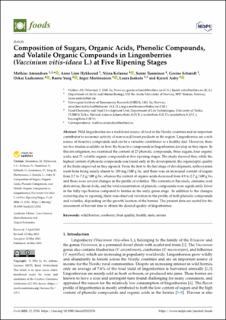Composition of Sugars, Organic Acids, Phenolic Compounds, and Volatile Organic Compounds in Lingonberries (Vaccinium vitis-idaea L.) at Five Ripening Stages
| dc.contributor.author | Amundsen, Mathias | |
| dc.contributor.author | Hykkerud, Anne Linn | |
| dc.contributor.author | Kelanne, Niina | |
| dc.contributor.author | Tuominen, Sanni | |
| dc.contributor.author | Schmidt, Gesine | |
| dc.contributor.author | Laaksonen, Oskar | |
| dc.contributor.author | Yang, Baoru | |
| dc.contributor.author | Martinussen, Inger | |
| dc.contributor.author | Jaakola, Laura | |
| dc.contributor.author | Aaby, Kjersti | |
| dc.date.accessioned | 2023-07-04T07:02:18Z | |
| dc.date.available | 2023-07-04T07:02:18Z | |
| dc.date.created | 2023-05-30T08:13:53Z | |
| dc.date.issued | 2023 | |
| dc.identifier.citation | Foods. 2023, 12 1-14. | |
| dc.identifier.issn | 2304-8158 | |
| dc.identifier.uri | https://hdl.handle.net/11250/3075443 | |
| dc.description.abstract | Wild lingonberries are a traditional source of food in the Nordic countries and an important contributor to economic activity of non-wood forest products in the region. Lingonberries are a rich source of bioactive compounds and can be a valuable contributor to a healthy diet. However, there are few studies available on how the bioactive compounds in lingonberries develop as they ripen. In this investigation, we examined the content of 27 phenolic compounds, three sugars, four organic acids, and 71 volatile organic compounds at five ripening stages. The study showed that, while the highest content of phenolic compounds was found early in the development, the organoleptic quality of the fruits improved as they ripened. From the first to the last stage of development, anthocyanins went from being nearly absent to 100 mg/100 g fw, and there was an increased content of sugars from 2.7 to 7.2 g/100 g fw, whereas the content of organic acids decreased from 4.9 to 2.7 g/100 g fw, and there were several changes in the profile of volatiles. The contents of flavonols, cinnamic acid derivatives, flavan-3-ols, and the total concentration of phenolic compounds were significantly lower in the fully ripe berries compared to berries in the early green stage. In addition to the changes occurring due to ripening, there was observed variation in the profile of both phenolic compounds and volatiles, depending on the growth location of the berries. The present data are useful for the assessment of harvest time to obtain the desired quality of lingonberries. | |
| dc.language.iso | eng | |
| dc.title | Composition of Sugars, Organic Acids, Phenolic Compounds, and Volatile Organic Compounds in Lingonberries (Vaccinium vitis-idaea L.) at Five Ripening Stages | |
| dc.title.alternative | Composition of Sugars, Organic Acids, Phenolic Compounds, and Volatile Organic Compounds in Lingonberries (Vaccinium vitis-idaea L.) at Five Ripening Stages | |
| dc.type | Peer reviewed | |
| dc.type | Journal article | |
| dc.description.version | publishedVersion | |
| dc.source.pagenumber | 1-14 | |
| dc.source.volume | 12 | |
| dc.source.journal | Foods | |
| dc.identifier.doi | 10.3390/foods12112154 | |
| dc.identifier.cristin | 2150009 | |
| dc.relation.project | Nofima AS: 12580 | |
| dc.relation.project | Norges forskningsråd: 294797 | |
| dc.relation.project | Nofima AS: 202101 | |
| dc.relation.project | Norges forskningsråd: 314599 | |
| cristin.ispublished | true | |
| cristin.fulltext | original | |
| cristin.qualitycode | 1 |
Tilhørende fil(er)
Denne innførselen finnes i følgende samling(er)
-
Artikler / Articles [1456]
-
Publikasjoner fra CRIStin [2533]
